
  
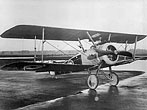  
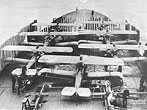  
  
  
  
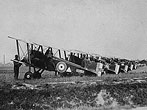  
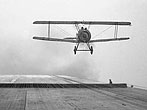  
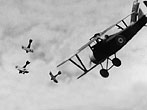  
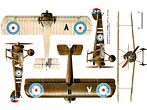  
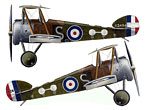  
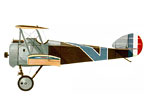  
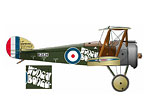  
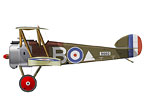  
  
  
  
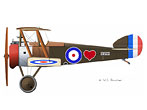  
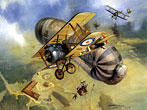  
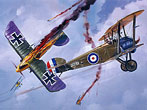  
|
 |
10 June 1917 - British Sopwith Camel Single-seat Biplane Fighter Aircraft
The Sopwith Camel was a British First World War single-seat biplane fighter introduced on the Western Front in 1917. Manufactured by Sopwith Aviation Company, it had a short-coupled fuselage, heavy, powerful rotary engine, and concentrated fire from twin synchronized machine guns. Though difficult to handle, to an experienced pilot it provided unmatched manoeuvrability. A superlative fighter, the Camel was credited with shooting down 1,294 enemy aircraft, more than any other Allied fighter of the war. It also served as a ground-attack aircraft, especially near the end of the conflict, when it was outclassed in the air-to-air role by newer fighters.
Design and development
Intended as a replacement for the Sopwith Pup,] the Camel prototype was first flown by Harry Hawker at Brooklands on 22 December 1916, powered by a 110 hp Clerget 9Z. Known as the "Big Pup" early on in its development, the biplane design was evolutionary more than revolutionary, featuring a box-like fuselage structure, an aluminium engine cowling, plywood-covered panels around the cockpit, and fabric-covered fuselage, wings and tail. For the first time on an operational British-designed fighter, two .303 in (7.7 mm) Vickers machine guns were mounted directly in front of the cockpit, firing forward through the propeller disc with synchronisation gear. A metal fairing over the gun breeches created a "hump" that led to the name Camel. The bottom wing had dihedral but not the top, so that the gap between the wings was less at the tips than at the roots. Approximately 5,490 Camels were built.
Unlike the preceding Pup and Triplane, the Camel was not considered pleasant to fly. The Camel owed its extreme manoeuvrability and its difficult handling to the close placement of the engine, pilot, guns and fuel tank (some 90% of the weight of the aircraft) within the front seven feet of the aircraft, coupled with the strong gyroscopic effect of the rotary engine. The Camel soon gained an unfortunate reputation with student pilots. The Clerget engine was particularly sensitive to fuel mixture control and incorrect settings often caused the engine to choke and cut out during take-off. Many crashed due to mishandling on take-off when a full fuel tank affected the centre of gravity. In level flight, the Camel was markedly tail-heavy. Unlike the Sopwith Triplane, the Camel lacked a variable incidence tailplane, so that the pilot had to apply constant forward pressure on the control stick to maintain a level attitude at low altitude. The aircraft could also be rigged so that at higher altitudes it was able to be flown "hands off." A stall immediately resulted in a particularly dangerous spin.
Operational history
Western front
The type entered squadron service in June 1917 with No. 4 Squadron of the Royal Naval Air Service, near Dunkirk. The following month, it became operational with No. 70 Squadron of the Royal Flying Corps. By February 1918, 13 squadrons were fully equipped with the Camel.
The Camel proved to be a superlative fighter, and offered heavier armament and better performance than the Pup and Triplane. In the hands of an experienced pilot, its manoeuvrability was unmatched by any contemporary type. Its controls were light and sensitive. The Camel turned rather slowly to the left, which resulted in a nose up attitude due to the torque of the rotary engine. But the engine torque also resulted in the ability to turn to the right in half the time of other fighters,[4] although that resulted in more of a tendency towards a nose down attitude from the turn. Because of the faster turning capability to the right, to change heading 90° to the left, many pilots preferred to do it by turning 270° to the right.
Agility in combat made the Camel one of the best-remembered Allied aircraft of the First World War. It was said in jest to offer a choice between a "wooden cross, red cross, and Victoria Cross."[citation needed] Together with the S.E.5a, the Camel helped to wrest aerial superiority away from the German Albatros fighters.
Major William Barker's Sopwith Camel (serial no. B6313, the aircraft in which he scored the majority of his victories,[5]) became the most successful fighter aircraft in the history of the RAF, shooting down 46 aircraft and balloons from September 1917 to September 1918 in 404 operational hours flying. It was dismantled in October 1918. Barker kept the clock as a memento, but was asked to return it the following day.
Home defence and night fighting
An important role for the Camel was home defence. The RNAS flew a number of Camels from Eastchurch and Manston airfields against daylight raids by German Gotha bombers from July 1917. The public outcry against these raids and the poor response of London's defences resulted in the RFC diverting Camel deliveries from France to home defence, with 44 Squadron RFC reforming on the Camel in the home defence role in July 1917.[6] When the Germans switched to night attacks, the Camel proved capable of being safely flown at night, and the home defence aircraft were modified with navigation lights to serve as night fighters. A number of Camels were more extensively modified as night fighters, with the Vickers machine guns being replaced by overwing Lewis guns, with the cockpit being moved rearwards so the pilot could easily reload the guns. This modification, which became known as the "Sopwith Comic" allowed the guns to be fired without affecting the night vision of the pilots, and allowed the use of new and more effective incendiary ammunition that was considered unsafe to fire from synchronised Vickers guns.[7][8][N 1] By March 1918, the home defence squadons were equipped with the Camel, with seven home defence squadrons flying Camels by August 1918.[10] Camels were also used as night fighters over the Western Front, with 151 Squadron intercepting German night raids over the front, and carrying out night intruder missions against German airstrips, claiming 26 German aircraft shot down in five months of operations.
Ground attack
By mid-1918, the Camel was becoming limited, especially as a day fighter, by its slow speed and comparatively poor performance at altitudes over 12,000 ft (3,650 m). However, it remained useful as a ground-attack and infantry support aircraft. During the German offensive of March 1918, flights of Camels harassed the advancing German Army, inflicting high losses (and suffering high losses in turn) through the dropping of 25 lb (11 kg) Cooper bombs and ultra-low-level strafing. The protracted development of the Camel's replacement, the Sopwith Snipe, meant that the Camel remained in service until the Armistice.
In summer 1918, a 2F.1 Camel (N6814) was used in trials as a parasite fighter under Airship R23
Sopwith Camel - Operators:
Australia: Australian Flying Corps
Belgium: Groupe de Chasse
Estonia: Estonian Air Force
Greece: Hellenic Navy
Latvia: Latvian Air Force
Netherlands: Royal Netherlands Air Force
Poland: Polish Air Force operated 1 Camel post-war (1921)
Russia: Imperial Russian Air Force
Soviet Union: Soviet Air Force - Postwar
Sweden: Swedish Air Force
United Kingdom: Royal Flying Corps / Royal Air Force
United States: American Expeditionary Force, United States Army Air Service
Sopwith Camel - Specifications:
Country: Great Britain
Manufacturer: Sopwith Aviation Company
Designer Herbert Smith
Type: Fighter
Role: Biplane fighter
First flight: 22 December 1916
Introduction: June 1917
Engine(s): Bentley BR.1, 150 hp, Reciprocating Le Rhône Rotary x 1, 110 hp, Clerget 9B, 9 cylinder, air cooled rotary, 130 hp, Clerget 9Bf, 9 cylinder, air cooled rotary, 140 hp
Wing Span: 28 ft
Length: 18 ft 8 in
Height: 8 ft 6 in
Empty Weight: 889 lb
Gross Weight: 1,422 lb
Max Speed: 118 mph
Ceiling: 19,000 ft]
Endurance: 2.5 hours
Crew: 1
Armament: 2 Vickers .303 machine guns (F.1), 1 Vickers .303 and 1 Lewis .303 machine guns or 2 Lewis .303 machine guns (2F.1)
Primary users: RFC (RAF), RNAS, AAF
Number built: 5.490
|